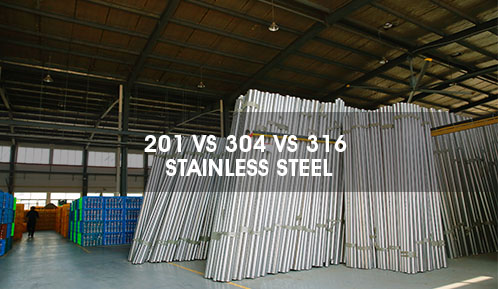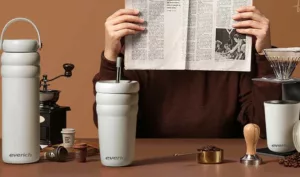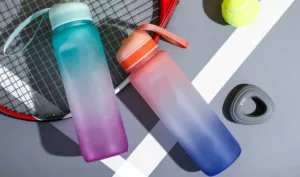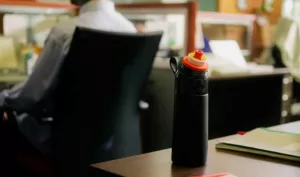When three different grades of stainless steel are placed side by side, in most cases the naked eye can never tell which is which. However, at the molecular level, there are huge differences.
The question of 201,304 versus 316 stainless steel is often one of the most important questions to answer when it comes to choosing a stainless steel material for their insulated water bottle project. Both common grades of stainless steel and one of the most common materials used to make insulated bottles share many characteristics, but also have some unique advantages that set them apart. So, what is 201 stainless steel, what is 304 stainless steel, and what is 316 stainless steel, and what is the difference between 201, 304 and 316 stainless steel?
In this article, we will compare 201, 304 versus 316 stainless steel head-to-head. Facilitating your choice when conducting your insulated water bottle business. If you’re going to invest in a stainless steel water bottle, you want to know whether it’s 316 or 304 or 201 and which of these three options will give you the best quality and durability at the best price.
What Is 201 Type Stainless Steel
Type 201 stainless steel is unique because it was created in response to the spike in nickel prices. This means it’s cheaper, but it also has a much lower nickel content. Without as much nickel, it’s not as effective at preventing corrosion.
The higher levels of manganese help make Type 201 one of the strongest types of stainless steel strip. Industries that prefer this type are those that want more durability at a lower cost and are not concerned about exposure to corrosive elements.
As with Type 304, this type is also commonly used for additional marking and other piping needs. Although it is not highly resistant to corrosion, it still offers good corrosion protection.
Type 201 stainless steel is particularly useful in cold environments, as its toughness remains constant in cold weather. To compensate for the lack of nickel, you will find it contains more manganese and nitrogen.
As the cheapest type of stainless steel, Type 201 seems the most attractive. Nevertheless, it won’t last long in highly corrosive environments.
What Is 304 Type Stainless Steel
304 stainless steel is also known in the industry as 18/8 stainless steel. It is a healthy material. It is now recognized as a health material that can be used for medical treatment and implantation in the human body. 304 stainless steel is also the most commonly used raw material for insulated water bottle manufacturer. For 304 stainless steel, the element Ni in its composition is very important and directly determines the corrosion resistance of 304 stainless steel and its value. Important elements in 304 are Ni, Cr, but are not limited to these two elements. Product standards specify specific requirements. The industry generally judges that as long as the Ni content is greater than 8% and the Cr content is greater than 18%, it can be considered 304 stainless steel. This is why the industry calls this stainless steel 18/8 stainless steel.
Commonly used stainless steel is mainly 201 and 304 stainless steel, 201 stainless steel contains manganese, corrosive properties in general, long-term consumption of water containing iron and manganese exceeds the standard will cause loss of appetite, vomiting, diarrhea, gastrointestinal disorders, bowel disorders and other diseases. 201 stainless steel color will be darker than 304, 304 stainless steel contains more chromium, has excellent corrosion resistance and better resistance to intergranular corrosion. Found in the test: nitric acid concentration ≤ 65% below the boiling point temperature, 304 stainless steel has strong corrosion resistance.
What Is 316 Type Stainless Steel
304 stainless steel has slightly more chromium and less nickel than 316. It is more corrosion resistant than 316 due to its higher chromium content, but 316 is more corrosion resistant overall due to its higher molybdenum content (approximately 0.2% of 304 and 0.4% of 316). For this reason, 316 is often recommended for use in marine environments or other situations where exposure to salt water or other corrosive chemicals may occur. This makes it a common choice for marine equipment and other applications where materials are exposed to extremely high concentrations of chlorides or other oxidizing agents. However, 304 stainless steel still has excellent corrosion resistance, so this is usually only a factor in marine environments and other highly corrosive locations.
Conclusion
304 stainless steel is the most common type of stainless steel on the market today. In fact, 304 stainless steel accounts for more than half of the world’s stainless steel supply. This is because 304 stainless steel offers an excellent balance between price and performance. Its strong corrosion resistance and extreme durability combine to make it the standard choice for many industries. 304 stainless steel is a versatile material for most applications, and choosing 304 steel almost always results in significant cost savings. Speaking as a stainless steel insulated water bottle manufacturer with over 20 years of extensive production experience, the vast majority of our exported insulated water bottles and tumbler are double wall 304 stainless steel inside and out. If your requirements are not too high, you can use 201 outside and 304 inside as the material for your insulated water bottle, on the other hand, if you make a product that really needs high corrosion resistance or you are looking for a higher quality stainless steel bottle and can accept the expensive material price, then 316 stainless steel will be your better choice. Please feel free to contact us for a better solution and quote for insulated water bottle and vacuum tumblers.




